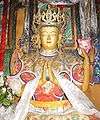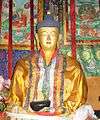Tsozong Gongba Monastery
| Tsozong Gongba Monastery | |
|---|---|
| Highest point | |
| Elevation | 3,540 m (11,610 ft) |
| Coordinates | 30°00′33″N 93°54′58″E / 30.00917°N 93.91611°E |
| Geography | |
| Location | Tibet |
| Parent range | Assam Himalaya |
| Climbing | |
| First ascent | 1040 Guru Rimpoché |
| Easiest route | 300km WE->Lhasa; 41km off Sichuan-Tibet Hwy |
Tsozong Gongba Monastery (also Tsodzong or Tsomum, 1400 AD; meaning 'castle in a lake') is a small sacred chapel of the Nyingma (Red) tradition of Tibetan Buddhism (monks wear red hats - see the other two Red Hat Sects).[1]
Buildings
Tsozong Gongba Monastery has four buildings situated around a small yard.
-

Tsozong Gongba Monastery main building with the statues of Avalokiteśvara, Guru Rimpoché and Buddha (see next gallery below).
-

Tsozong Gongba Monastery auxiliary building with 3 'endless knots' above the door.
-

Tashi Island in the middle of the Basum Tso Lake, behind is peak (6,200 km).
-

Om mani padme hum -variation of the six syllable mantra of Avalokiteshvara.[1] is inscribed in Tibetan script[2] on this rock behind the main building.
- ^ Tibet, Life, Myth, and Art by Michael Willis, Thorsons 2003, p.69
- ^ Tibetan Phrasebook by Sandup Tsering, Lonely Planet Publications, 2002, pp.15-17
Symbolism
The construction of the Tsozong Gongba Monastery was chaired by the Nyin-gma-pa monk Sungye Lingpa and is now home of few nuns.
The three statues (Chenresig, Guru Rimpoché and Sakya Thukpa, see above) were actually shot and burned by the People's Liberation Army (PLA) during the Cultural Revolution, before being restored by the local lama Dudjom Rimpoche and his son Chuni Rimpoche (now resident of at Lamaling Monastery near Bayi town,[2] see the map on your left). A small 'kora' (ritual circumambulation circuit, see also Kora (pilgrimage)) around the monastery passes several hard-to-discern holy sites, including a Sky burial site, a 'body-print' of Gesar.
-

Avalokiteshvara (or Avalokiteśvara, in Tibetan - Chenresig) - statue in the main building.
-

Padmasambhava (or Guru Rimpoché) - statue in the main building.
-

Buddha Shakyamuni (Sakya Thukpa) - statue in the main building.
Directions
Tsozong Gongba Monastery is located on the Tashi (in Chinese Zha-Xi/Tsa-Xi, 扎西) Island in the middle of the Basum Tso Lake (also Baksum Tso, Draksum-tso) - Eastern Tibet’s largest freshwater lake. Because of the water's stunning jade green effect its meaning in Tibetan - "Phasongtso" is "green water" (Cuogao). The color is due to Songluo (lit. pine-vine). Basum Tso Lake lies about 50 km east of Kongpo Gyamda County. The lake surface is on average about 3,538 meters above sea level and covers an area of 25.9 square kilometers, with a length of 12 km and a few hundreds to a few thousands meters in width. The deepest part is about 60 (198 feet) meters deep.
Tsozong Gongba Monastery can be reached via the Mila Pass with 16,500 feet above sea level. Zig-zagging the way over mountain passes one will ascend to over 4,450m driving over the Serkhyin La Pass. From the back of mongastery is revealed spectacular views of Namcha Barwa, the highest peak in the East Himalayas (7782m).
References
See also
| Wikimedia Commons has media related to Tsozong Gongba Monastery. |